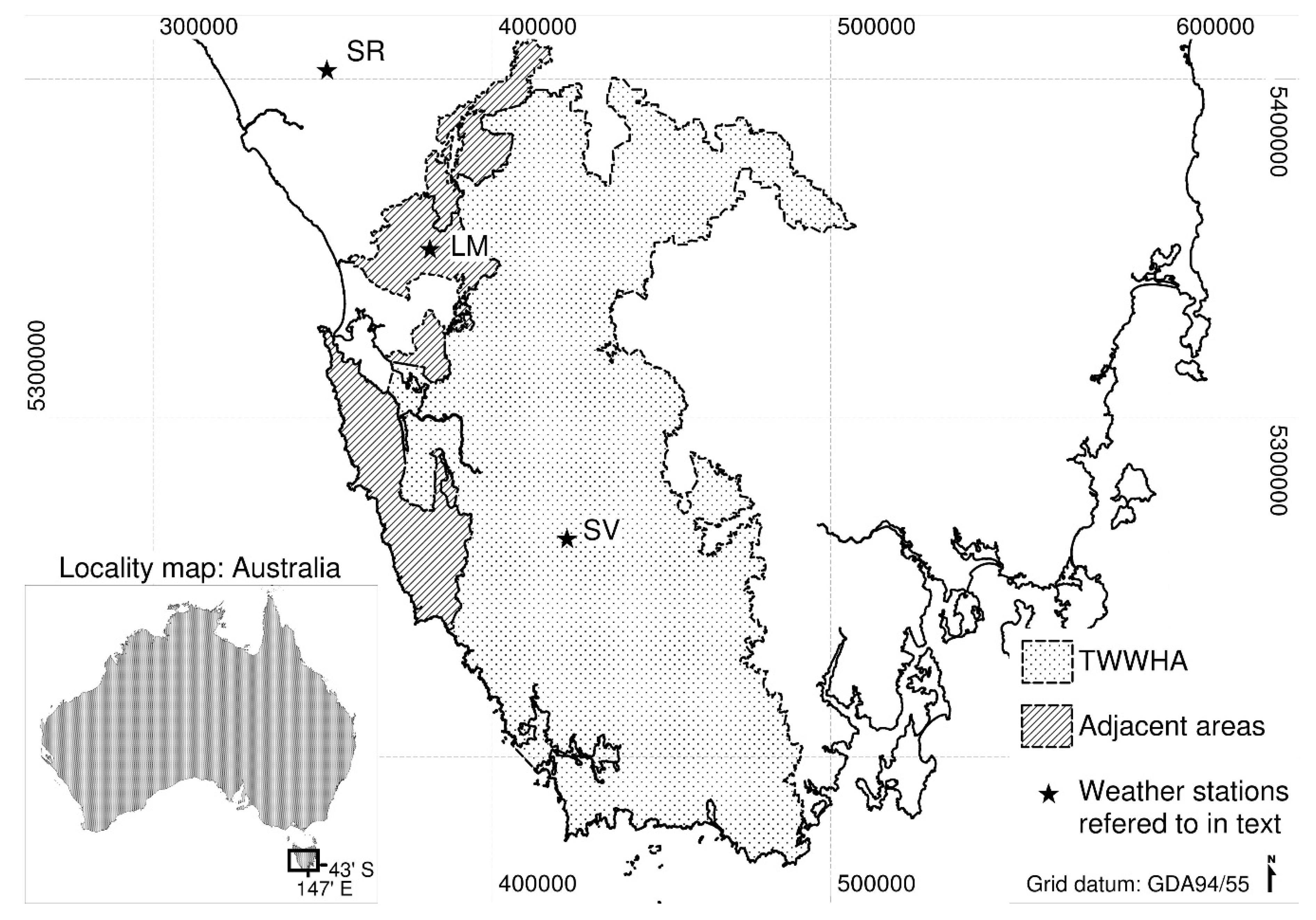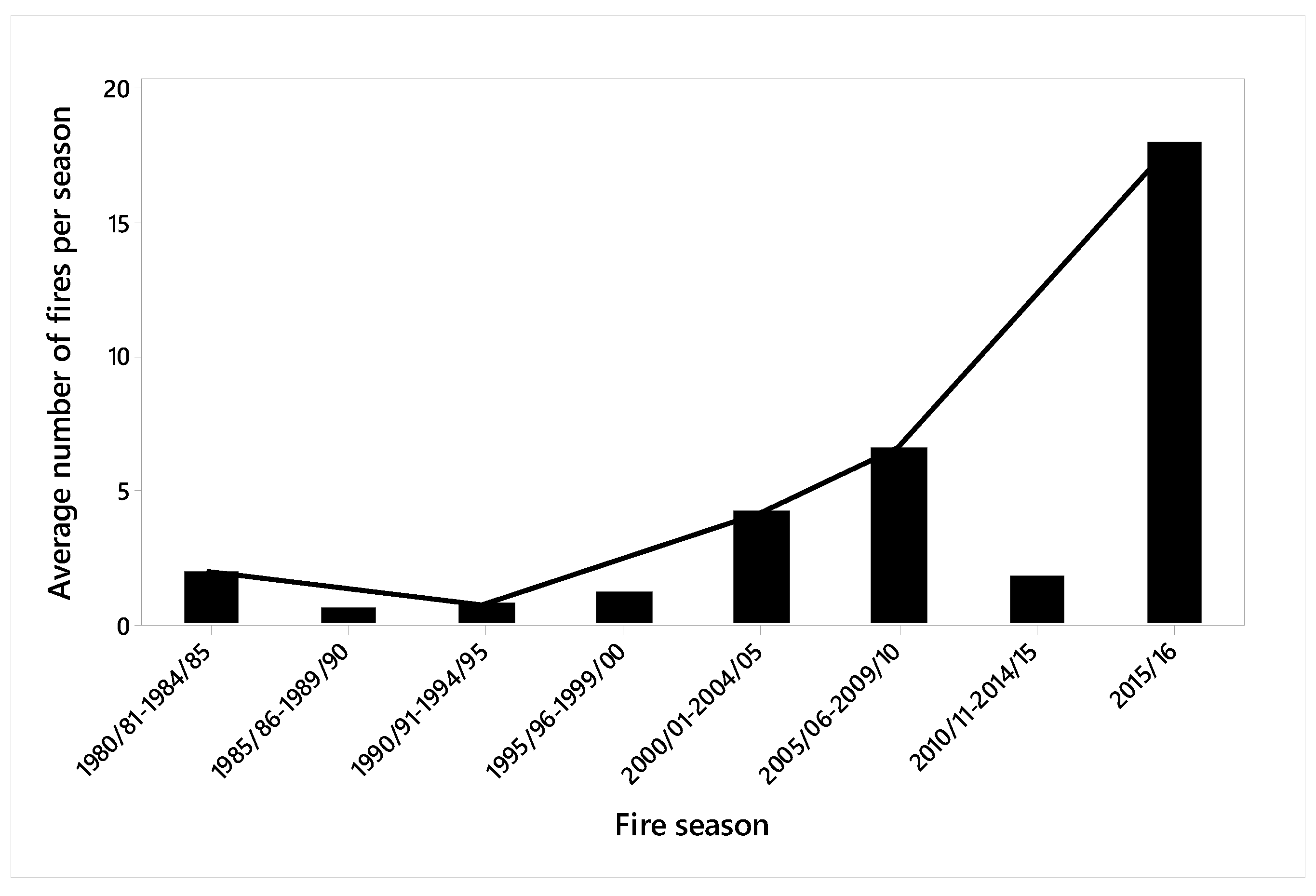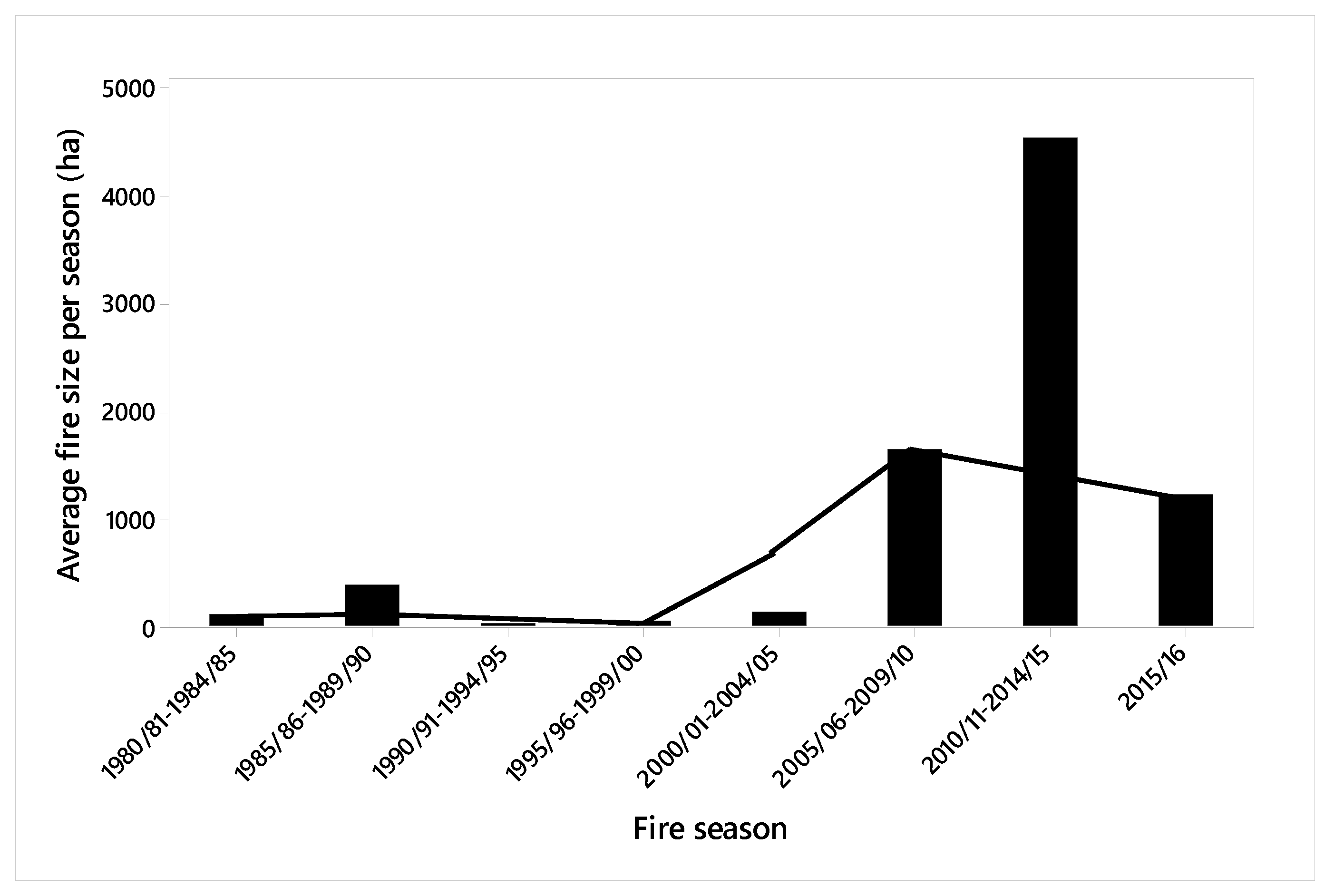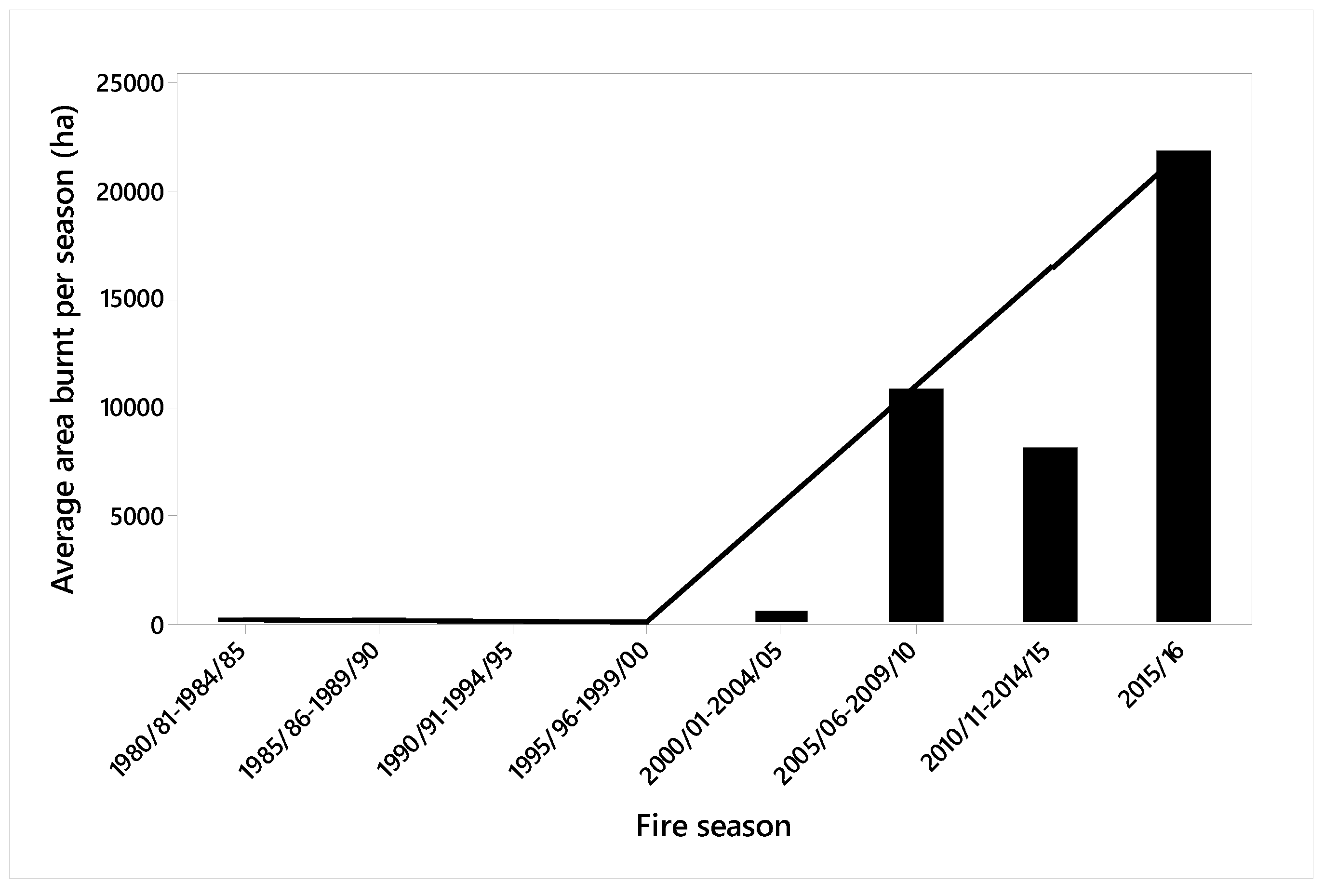Changes in Lightning Fire Incidence in the Tasmanian Wilderness World Heritage Area, 1980–2016
Abstract
1. Introduction
2. Materials and Methods
3. Results
4. Discussion
Future Outlook
Author Contributions
Funding
Acknowledgments
Conflicts of Interest
Appendix A
| 1980/81–1984/85 | 1985/86–1989/90 | 1990/91–1994/95 | 1995/96–1999/00 | 2000/01–2004/05 | 2005/06–2009/10 | 2010/11–2014/15 | 2015/16 | Total | |
|---|---|---|---|---|---|---|---|---|---|
| Arson | |||||||||
| Number | 22 | 24 | 23 | 18 | 15 | 14 | 16 | 0 | 132 |
| Area | 15144 | 37979.2 | 1360.6 | 1001.6 | 6450.1 | 269.8 | 2250.2 | 0 | 64455.5 |
| Av size | 688.4 | 1582.5 | 59.2 | 55.6 | 430 | 19.3 | 140.6 | 0 | 488.3 |
| Escaped campfires and stoves | |||||||||
| Number | 3 | 2 | 5 | 0 | 1 | 10 | 31 | 0 | 52 |
| Area | 7921.7 | 86.3 | 456.7 | 0 | 0.2 | 5 | 0.1 | 0 | 8470 |
| Av size | 2640.6 | 43.1 | 91.3 | 0 | 0.2 | 0.5 | 0 | 0 | 162.9 |
| Escaped management burns | |||||||||
| Number | 1 | 5 | 0 | 2 | 1 | 1 | 1 | 0 | 11 |
| Area | 1763.9 | 41849.6 | 0 | 5412.8 | 4729.9 | 429.5 | 1.2 | 0 | 54186.9 |
| Av size | 1763.9 | 8369.9 | 0 | 2706.4 | 4729.9 | 429.5 | 1.2 | 0 | 4926.1 |
| Lightning | |||||||||
| Number | 10 | 3 | 4 | 6 | 21 | 33 | 9 | 18 | 104 |
| Area | 1089.1 | 1177.7 | 123.9 | 298.5 | 2747.8 | 53991.7 | 40733.2 | 21897.2 | 122059.1 |
| Ave size | 108.9 | 392.6 | 31 | 49.8 | 130.8 | 1636.1 | 4525.9 | 1216.5 | 1173.6 |
| Planned burns | |||||||||
| Number | 10 | 9 | 9 | 22 | 37 | 52 | 27 | 0 | 166 |
| Area | 9904.4 | 1506.3 | 794.1 | 3522.7 | 9767 | 10976.7 | 18102.7 | 0 | 54573.9 |
| Av size | 990.4 | 167.4 | 88.2 | 160.1 | 264 | 211.1 | 670.5 | 0 | 328.8 |
| Miscellaneous | |||||||||
| Number | 2 | 5 | 4 | 0 | 4 | 5 | 1 | 0 | 21 |
| Area | 157.3 | 3018.8 | 158.6 | 0 | 2829.1 | 7 | 0.2 | 0 | 6171 |
| Av size | 78.6 | 603.8 | 0 | 0 | 707.3 | 1.4 | 0.2 | 0 | 293.9 |
| Total, all fire types | |||||||||
| Number | 48 | 48 | 45 | 48 | 79 | 115 | 85 | 18 | 486 |
| Area | 35980.4 | 85617.9 | 2893.9 | 10235.6 | 26524.1 | 65679.7 | 61087.6 | 21897.2 | 309916.4 |
| Av size | 6270.8 | 11159.3 | 269.7 | 2971.9 | 6262.2 | 2297.9 | 5338.4 | 1216.5 | 637.7 |
References
- Australian Government. Available online: http://www.environment.gov.au/ (accessed on 7 September 2018).
- DPIPWE. Tasmanian Wilderness World Heritage Area Management Plan 2016; Department of Primary Industries, Parks, Water and Environment: Hobart, TAS, Australia, 2016. [Google Scholar]
- Jordan, G.J.; Harrison, P.A.; Worth, J.R.P.; Williamson, G.J.; Kirkpatrick, J.B. Palaeoendemic plants provide evidence for persistence of open, well-watered vegetation since the Cretaceous. Glob. Ecol. Biogeogr. 2016, 25, 127–140. [Google Scholar] [CrossRef]
- Balmer, J.; Storey, D. A Review of Vegetation Responses to Fire in Buttongrass Moorland; Buttongrass Moorland Management Workshop: Hobart, TAS, Australia, 2010. [Google Scholar]
- Johnson, K.A.; Marsden-Smedley, J.B. Fire history of the northern part of the Tasmanian Wilderness World Heritage Area and its associated regions. Pap. Proc. R. Soc. Tasman. 2002, 136, 145–152. [Google Scholar] [CrossRef]
- Marsden-Smedley, J.B. Changes in southwestern Tasmanian fire regimes since the early 1800s. Pap. Proc. R. Soc. Tasman. 1998, 132, 15–29. [Google Scholar] [CrossRef]
- Marsden-Smedley, J.B.; Kirkpatrick, J.B. Fire management in Tasmania’s Wilderness World Heritage Area: Ecosystem restoration using Indigenous-style fire regimes? Ecol. Manag. Restor. 2000, 1, 195–203. [Google Scholar] [CrossRef]
- Marsden-Smedley, J.B. Tasmanian wildfires January–February 2013: Forcett-Dunalley, Repulse, Bicheno, Giblin River, Montumana, Molesworth and Gretna; Report prepared for the Tasmania Fire Service and Bushfire Co-operative Research Centre: Hobart, TAS, Australia, 2014. [Google Scholar]
- Black, P. Personal Communication; Tasmania Parks and Wildlife Service: Hobart, TAS, Australia, 2018. [Google Scholar]
- Krause, A.; Klostner, S.; Wilkenskjeld, S.; Paeth, H. The sensitivity of global wildfires to simulated past, present, and future lightning frequency. J. Geophys. Res. Biogeosci. 2014, 119, 312–322. [Google Scholar] [CrossRef]
- Paz, S.; Inbar, M.; Kutiel, H.; Malkinson, D.; Tessler, N.; Wittenberg, L. Wildfires in the eastern Mediterranean as a result of lightning activity – A change in the conventional knowledge. Int. J. Wildland Fire 2016, 25, 592–596. [Google Scholar] [CrossRef]
- Woolford, D.G.; Dean, C.B.; Martell, D.L.; Cao, J.; Wotton, B.M. Lightning-caused forest fire risk in Northwestern Ontario, Canada, is increasing and associated with anomalies in fire weather. Environmetrics 2014, 25, 406–416. [Google Scholar] [CrossRef]
- Wotton, B.M.; Nock, C.A.; Flannigan, M.D. Forest fire occurrence and climate change in Canada. Int. J. Wildland Fire 2010, 19, 253–271. [Google Scholar] [CrossRef]
- Bowman, D.M.J.S.; Balch, J.K.; Artaxo, P.; Bond, W.J.; Carlson, J.M.; Cochrane, M.A.; D’Antonio, C.M.; DeFries, R.S.; Doyle, J.C.; Harrison, S.P. Fire in the Earth system. Science 2009, 324, 481–484. [Google Scholar] [CrossRef] [PubMed]
- Flannigan, M.D.; Wotton, B.M. Lightning-ignited forest fires in northwestern Ontario. Can. J. For. Res. 1991, 21, 277–287. [Google Scholar] [CrossRef]
- Flannigan, M.D.; Krawchuk, M.A.; de Groot, W.J.; Wotton, B.M.; Gowman, L.M. Implications of changing climate for global wildland fire. Int. J. Wildland Fire 2009, 18, 483–507. [Google Scholar] [CrossRef]
- Bowman, D.M.J.S; Jackson, W.D. Vegetation succession in southwest Tasmania. Search 1981, 12, 358–362. [Google Scholar]
- Marsden-Smedley, J.B. Planned Burning in Tasmania: Operational Guidelines and Review of Current Knowledge; Parks and Wildlife Service, Department of Primary Industries, Parks, Water and Environment: Hobart, TAS, Australia, 2009. [Google Scholar]
- Mount, A.B. The Derivation and Testing of a Soil Dryness Index Using Run-Off Data; Bulletin no. 4; Tasmanian Forestry Commission: Hobart, TAS, Australia, 1972. [Google Scholar]
- Marsden-Smedley, J.B.; Rudman, T.; Pyrke, A.; Catchpole, W.R. Buttongrass moorland fire-behaviour prediction and management. Tasforests 1999, 11, 87–107. [Google Scholar]
- Marsden-Smedley, J.B.; Catchpole, W.R.; Pyrke, A. Fire modelling in Tasmanian buttongrass moorlands. IV. Sustaining versus non-sustaining fires. Int. J. Wildland Fire 2001, 10, 255–262. [Google Scholar] [CrossRef]
- Michalon, N.; Nassif, A.; Saouri, T.; Royer, J.F.; Pontikis, C.A. Contribution to the climatological study of lightning. Geophys. Res. Lett. 1999, 26, 3097–3100. [Google Scholar] [CrossRef]
- Price, C.; Rind, D. Possible implications of global climate change on global lightning distributions and frequencies. J. Geophys. Res. 1994, 99, 823–831. [Google Scholar] [CrossRef]
- Romps, D.M.; Seeley, J.T.; Vollaro, D.; Molinari, J. Projected increase in lightning strikes in the United States due to global warming. Science 2014, 346, 851–854. [Google Scholar] [CrossRef] [PubMed]
- Veraverbeke, S.; Rogers, B.M.; Goulden, M.L.; Jandt, R.R.; Miller, C.E.; Wiggins, E.B.; Randerson, J.T. Lightning as a major driver of recent large fire years in North American boreal forests. Nat. Clim. Chang. 2017, 7, 529–534. [Google Scholar] [CrossRef]
- Abatzoglou, J.T.; Kolden, C.A.; Balch, J.K.; Bradley, B.A. Controls on interannual variability in lightning-caused fire activity in the western US. Environ. Res. Lett. 2016, 11, 045005. [Google Scholar] [CrossRef]
- Hall, B. Precipitation associated with lightning-ignited wildfires in Arizona and New Mexico. Int. J. Wildland Fire 2007, 16, 242–254. [Google Scholar] [CrossRef]
- Burch, G.J.; Moore, I.D.; Burns, J. Soil hydrophobic effects on infiltration and catchment runoff. Hydrol. Process. 1989, 3, 211–222. [Google Scholar] [CrossRef]
- Liu, H.; Lei, T.W.; Zhao, J.; Yuan, C.P.; Fan, Y.T.; Qu, L.Q. Effects of rainfall intensity and antecedent soil water content on soil infiltrability under rainfall conditions using the run off-on-out method. J. Hydrol. 2011, 396, 24–32. [Google Scholar] [CrossRef]
- Hill, R.S.; Read, J. Post-fire regeneration of rainforest and mixed forest in Western Tasmania. Aust. J. Bot. 1984, 32, 481–493. [Google Scholar] [CrossRef]
- Taylor, C.; McCarthy, M.A.; Lindenmayer, D.B. Nonlinear Effects of Stand Age on Fire Severity. Conserv. Lett. 2014, 7, 355–370. [Google Scholar] [CrossRef]
- Marsden-Smedley, J.B.; Catchpole, W.R. Fire behaviour modelling in Tasmanian buttongrass moorlands. I. Fuel characteristics. Int. J. Wildland Fire 1995, 5, 203–214. [Google Scholar] [CrossRef]
- Balch, J.K.; Bradley, B.A.; Abatzoglou, J.T.; Nagy, R.C.; Fusco, E.J.; Mahood, A.L. Human-started wildfires expand the fire niche across the United States. Proc. Natl. Acad. Sci. USA 2017, 114, 2946–2951. [Google Scholar] [CrossRef] [PubMed]
- Love, P.T.; Fox-Hughes, P.; Harris, R.; Remenyi, T.; Bindoff, N. Impact of Climate Change on Weather-Related fire Risk Factors in the TWWHA: Interim Report; Tasmania Climate Change Office: Hobart, TAS, Australia, 2016. [Google Scholar]
- Styger, J.K.; Kirkpatrick, J.B. Less than 50 millimetres of rainfall in the previous month predicts fire in Tasmanian rainforest. Pap. Proc. R. Soc. Tasman. 2015, 149, 1–5. [Google Scholar] [CrossRef]
- Kirkpatrick, J.B.; Nunez, M.; Bridle, K.L.; Parry, J.; Gibson, N. Causes and consequences of variation in snow incidence on the high mountains of Tasmania, 1983–2013. Aust. J. Bot. 2017, 65, 214–224. [Google Scholar] [CrossRef]
- King, K.J.; Cary, G.J.; Bradstock, R.A.; Chapman, J.; Pyrke, A.; Marsden-Smedley, J.B. Simulation of prescribed burning strategies in south-west Tasmania, Australia: effects on unplanned fires, fire regimes, and ecological management values. Int. J. Wildland Fire 2006, 15, 527–540. [Google Scholar] [CrossRef]




| Station | Mean Rainfall | R-sq (%) | p-Value |
|---|---|---|---|
| Summer | |||
| Strathgordon | 447.0 | 3.7 | 0.261 |
| Lake Margaret | 525.9 | 2.3 | 0.375 |
| Savage River | 284.0 | 0.6 | 0.650 |
| Spring | |||
| Strathgordon | 711.1 | 1.9 | 0.427 |
| Lake Margaret | 807.0 | 11.5 | 0.043 |
| Savage River | 485.1 | 8.8 | 0.078 |
| Number of Fires | Area Burnt | |||
|---|---|---|---|---|
| Spearman Value | p-Value | Spearman Value | p-Value | |
| Strathgordon | 0.287 | 0.090 | −0.308 | 0.068 |
| Lake Margaret | 0.241 | 0.157 | 0.375 | 0.024 |
| Savage River | 0.273 | 0.107 | 0.312 | 0.064 |
| Standard Error of SDI | 75–100th Percentile of SDI | |||
|---|---|---|---|---|
| Spearman Value | p-Value | Spearman Value | p-Value | |
| Number of fires | 0.714 | <0.001 | 0.695 | <0.001 |
| Area burnt | 0.620 | <0.001 | 0.605 | <0.001 |
© 2018 by the authors. Licensee MDPI, Basel, Switzerland. This article is an open access article distributed under the terms and conditions of the Creative Commons Attribution (CC BY) license (http://creativecommons.org/licenses/by/4.0/).
Share and Cite
Styger, J.; Marsden-Smedley, J.; Kirkpatrick, J. Changes in Lightning Fire Incidence in the Tasmanian Wilderness World Heritage Area, 1980–2016. Fire 2018, 1, 38. https://doi.org/10.3390/fire1030038
Styger J, Marsden-Smedley J, Kirkpatrick J. Changes in Lightning Fire Incidence in the Tasmanian Wilderness World Heritage Area, 1980–2016. Fire. 2018; 1(3):38. https://doi.org/10.3390/fire1030038
Chicago/Turabian StyleStyger, Jenny, Jon Marsden-Smedley, and Jamie Kirkpatrick. 2018. "Changes in Lightning Fire Incidence in the Tasmanian Wilderness World Heritage Area, 1980–2016" Fire 1, no. 3: 38. https://doi.org/10.3390/fire1030038
APA StyleStyger, J., Marsden-Smedley, J., & Kirkpatrick, J. (2018). Changes in Lightning Fire Incidence in the Tasmanian Wilderness World Heritage Area, 1980–2016. Fire, 1(3), 38. https://doi.org/10.3390/fire1030038





